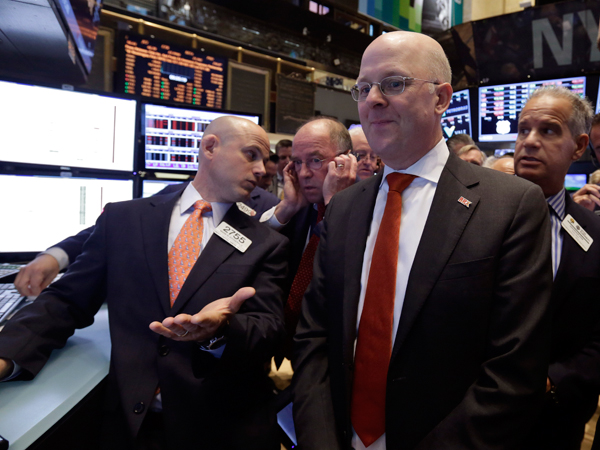
Brixmor Property Group CEO Michael Carroll, foreground right, watches as his company’s stock is priced during its IPO on the floor of the New York Stock Exchange Wednesday, Oct. 30, 2013. US stocks Wednesday closed lower after the US Federal Reserve maintained an aggressive monetary stimulus program and reiterated that it will await stronger economic conditions before scaling it back. AP
NEW YORK CITY—US stocks Wednesday closed lower after the US Federal Reserve maintained an aggressive monetary stimulus program and reiterated that it will await stronger economic conditions before scaling it back.
The Dow Jones Industrial Average fell 61.59 (0.39 percent) to 15,618.76.
The broad-based S&P 500 declined 8.64 (0.49 percent) to 1,763.31, while the tech-rich Nasdaq Composite Index gave up 21.72 (0.55 percent) at 3,930.62.
The Fed’s decision to hold steady on its $85 billion per-month bond-buying program, though bullish for stocks, was widely anticipated and had helped propel the Dow and S&P 500 to records Tuesday.
Analysts said the markets were due for a break.
“It’s just a case of profit taking,” said William Lynch, director of investment for Hinsdale Associates.
The market “has been so strong that it’s been due for a breather.”
US auto giant General Motors powered 3.2 percent higher after earnings excluding special items bested expectations by three cents at 96 cents per share. The company reported better results in North America and a narrowed loss in Europe.
Video game developer Electronic Arts jumped 7.8 percent after reporting earnings of 33 cents per share, more than double the 12 cents expected by analysts. The company also raised its earnings forecast.
Pharmaceutical company Gilead Sciences jumped 4.6 percent after earnings rose 17 percent to $788.6 million and the company raised its revenue forecast and plans for research and development spending. Sales of antiviral products were particularly strong.
Money transfer firm Western Union sank 12.4 percent after announcing that it expects operating profit growth to stall in 2014 due to significantly higher regulatory costs.
Internet networking site LinkedIn sank 9.3 percent after the company’s fourth-quarter revenue forecast of $415-$420 million lagged analyst forecasts of $438.1 million.
Bond prices fell. The yield on the 10-year US Treasury rose to 2.53 percent from 2.51 percent Tuesday, while the 30-year edged higher to 3.63 percent from 3.62 percent. Bond prices and yields move inversely.